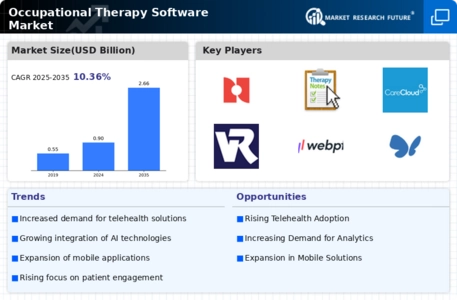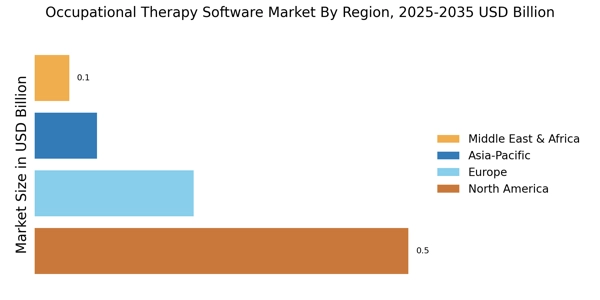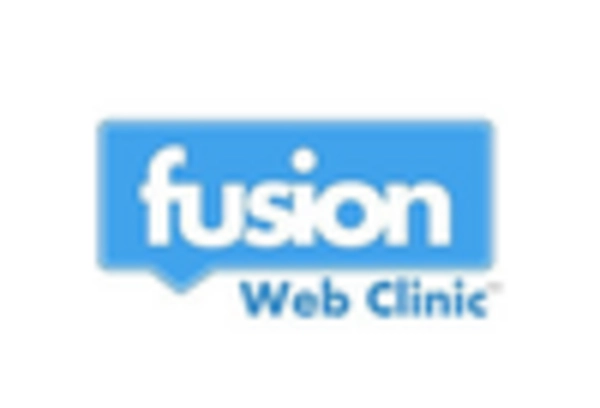Growing Awareness of Mental Health
The growing awareness of mental health issues is significantly impacting the Occupational Therapy Software Market. As society becomes more cognizant of the importance of mental well-being, there is an increasing recognition of the role that occupational therapy plays in addressing these concerns. Occupational therapists are often at the forefront of mental health interventions, helping individuals develop coping strategies and improve their daily functioning. This heightened awareness is leading to a greater demand for software solutions that support mental health therapy, including tools for assessment, progress tracking, and communication. Consequently, the Occupational Therapy Software Market is likely to expand as more practitioners seek to incorporate mental health-focused features into their software offerings, thereby enhancing the overall therapeutic experience.
Increased Focus on Patient-Centered Care
The Occupational Therapy Software Market is witnessing a shift towards patient-centered care, which emphasizes the importance of tailoring therapy to individual patient needs. This approach is gaining traction as healthcare systems recognize the value of personalized treatment plans in improving patient satisfaction and outcomes. Software solutions that facilitate the customization of therapy programs are becoming increasingly popular among occupational therapists. By leveraging data analytics, these tools enable practitioners to track patient progress and adjust interventions accordingly. The emphasis on patient-centered care not only enhances the therapeutic experience but also aligns with broader healthcare trends aimed at improving quality of care. As a result, the focus on patient-centered care is likely to drive the adoption of innovative software solutions within the Occupational Therapy Software Market.
Rising Demand for Rehabilitation Services
The Occupational Therapy Software Market is experiencing a notable increase in demand for rehabilitation services. This trend is driven by an aging population that requires more extensive therapeutic interventions. According to recent statistics, the number of individuals aged 65 and older is projected to reach 1.5 billion by 2050, which suggests a growing need for occupational therapy solutions. As healthcare providers seek to enhance patient outcomes, the integration of specialized software becomes essential. This software not only streamlines the management of therapy sessions but also facilitates better communication between therapists and patients. Consequently, the rising demand for rehabilitation services is likely to propel the growth of the Occupational Therapy Software Market, as organizations invest in technology to meet the evolving needs of their clientele.
Technological Advancements in Therapy Tools
Technological advancements are significantly influencing the Occupational Therapy Software Market. Innovations such as artificial intelligence, machine learning, and virtual reality are being integrated into therapy software, enhancing the effectiveness of treatment plans. For instance, AI-driven analytics can provide therapists with insights into patient progress, allowing for more personalized care. Furthermore, the incorporation of virtual reality in therapy sessions has shown promising results in improving patient engagement and outcomes. As these technologies continue to evolve, they are expected to attract more healthcare providers to adopt advanced occupational therapy software solutions. This trend indicates a shift towards more sophisticated and efficient therapeutic practices, thereby driving the growth of the Occupational Therapy Software Market.
Regulatory Changes and Compliance Requirements
Regulatory changes and compliance requirements are shaping the landscape of the Occupational Therapy Software Market. As healthcare regulations evolve, there is an increasing need for software solutions that ensure compliance with standards such as HIPAA and other data protection laws. Occupational therapy practices must adopt software that not only enhances operational efficiency but also safeguards patient information. This necessity is driving the demand for software that includes robust security features and compliance tracking capabilities. As regulatory scrutiny intensifies, the Occupational Therapy Software Market is likely to see a surge in the development and adoption of solutions that address these compliance challenges, ensuring that practitioners can focus on delivering quality care while adhering to legal requirements.


















Leave a Comment